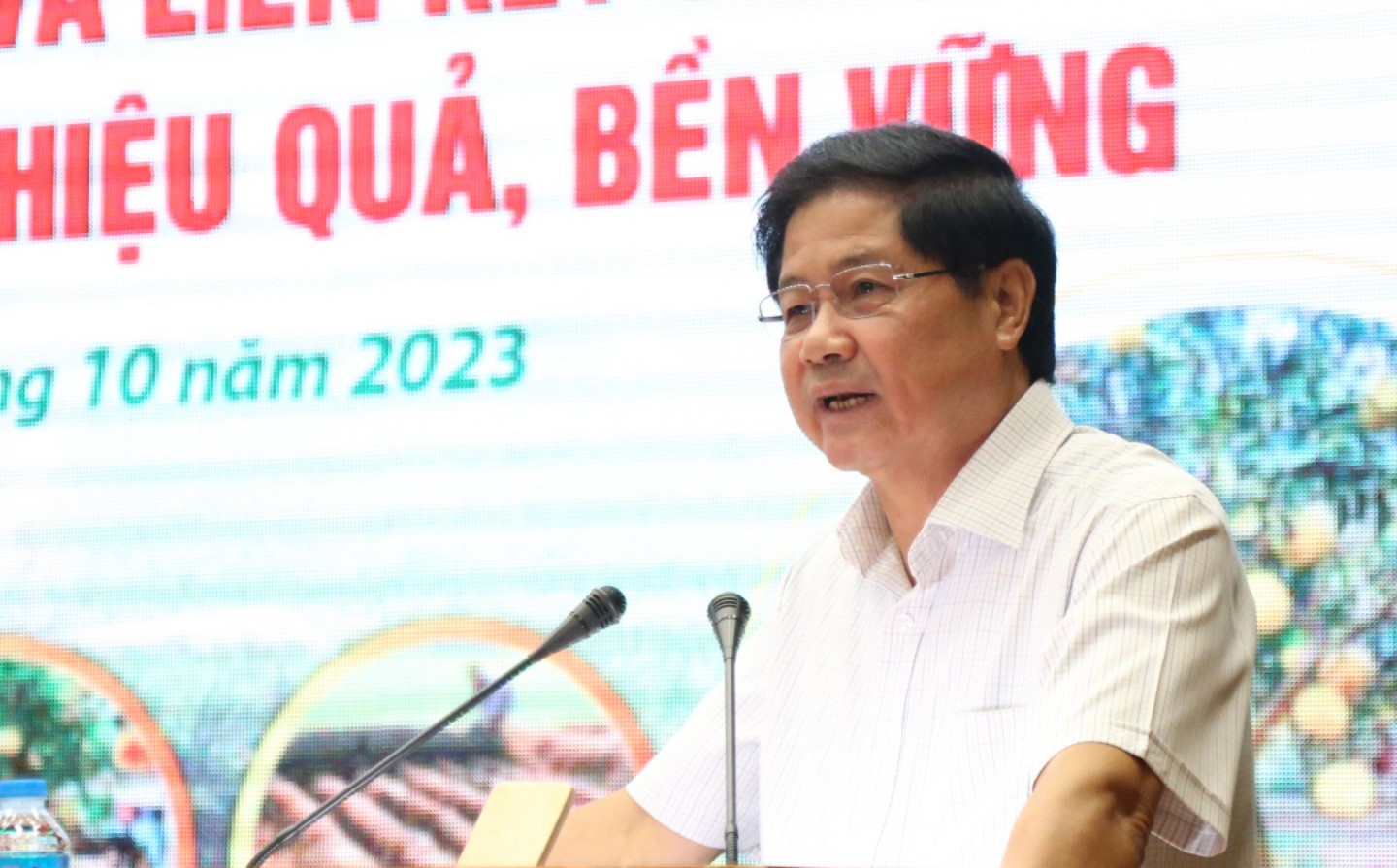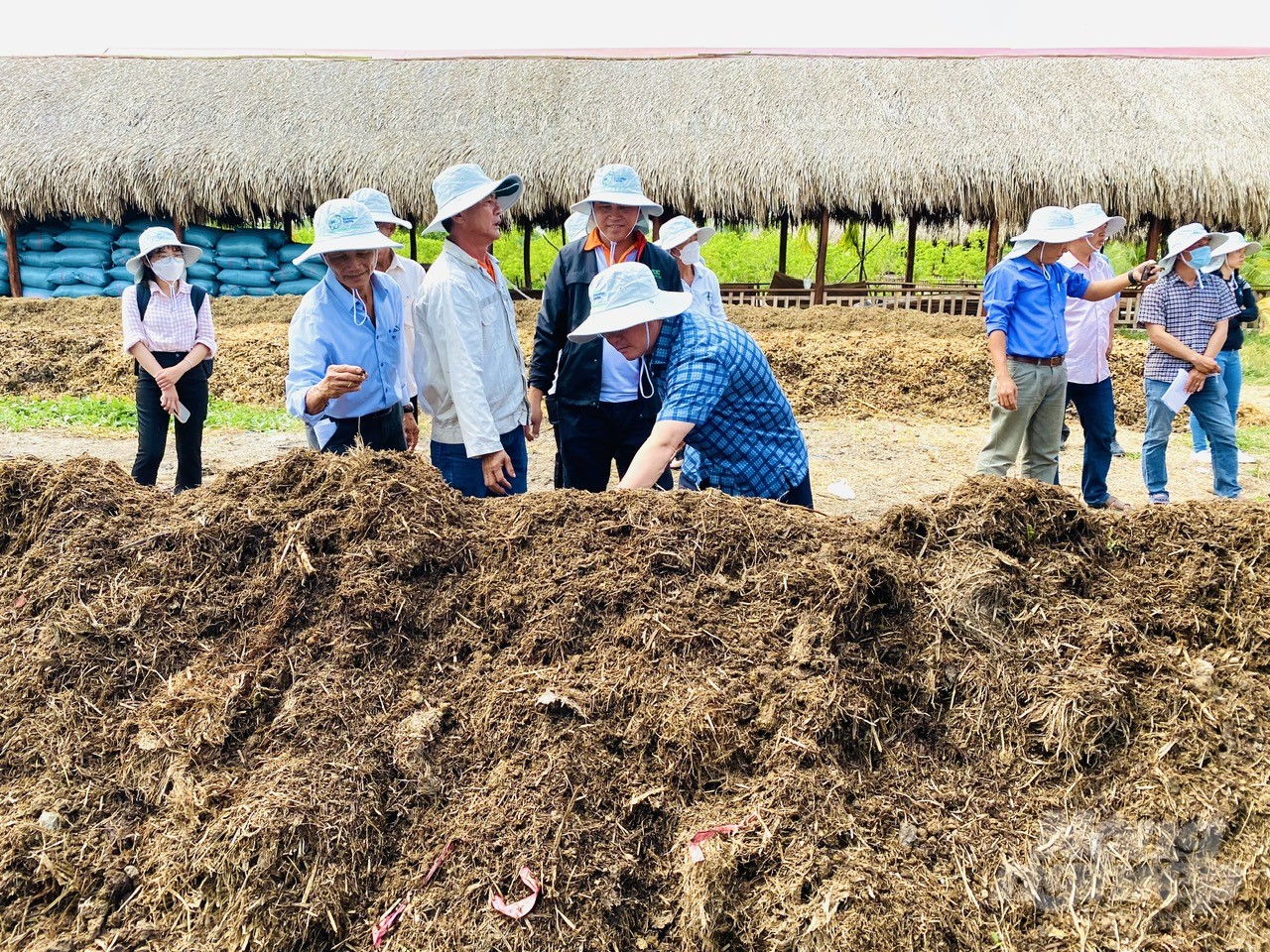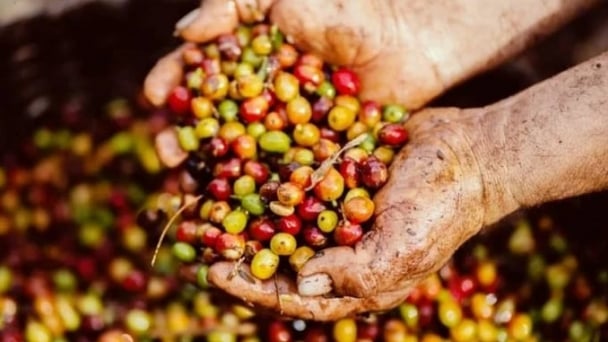June 18, 2025 | 11:19 GMT +7
June 18, 2025 | 11:19 GMT +7
Hotline: 0913.378.918
June 18, 2025 | 11:19 GMT +7
Hotline: 0913.378.918
On October 6, in Bac Giang province, the National Agricultural Extension Center, in collaboration with the Vietnam Gardening Association, organized the Agricultural Extension @ Agriculture forum with the theme "Solutions to promote the application of circular agriculture, multi-value agriculture, and chain linkages for effective and sustainable VAC economic development".

Mr. Le Quoc Doanh, former Deputy Minister of Agriculture and Rural Development and Chairman of the Vietnam Gardening Association, shared: "Doing VAC economy requires perseverance and enthusiasm." Photo: Lam Hung.
Regarding the importance of the VAC model (garden – pond – barn) in the process of promoting circular agriculture, Dr. Phan Huy Thong, Vice Chairman of the Vietnam Gardening Association, said that the garden economy, or VAC economy, is an important formant of the rural household economy and agricultural economy in Vietnam.
Except for large-scale estates of large companies and economic groups in agriculture, the remaining types of household gardens, farms, and small and medium farms of households, cooperative groups, and cooperatives that produce vegetables, flowers, fruits, industrial crops, medicinal plants, cattle and poultry farming, aquaculture, etc., all fall under the VAC economic scope.
According to preliminary statistics for 2021, the VAC economy accounts for over 80% of vegetable and fruit output, over 60% of meat and egg output, and about 70% of aquaculture output.
VAC also accounts for 50–60% of Vietnam's export volume of vegetables, fruits, and seafood and over 70% of OCOP products. On the other hand, the garden economy also creates conditions for a strong shift in agricultural production structure in a direction of multi-value, combining agriculture with the processing industry, and developing eco-tourism and training and entertainment services. This shift aims to improve land use efficiency, increase value, create more jobs and income for farmers, improve the ecological environment and landscape, and make an important contribution to new rural construction.

Circular agriculture models utilizing agricultural scrap and by-products in Vietnam are still not popular. Photo: LHV.
At the forum, former Deputy Minister of Agriculture and Rural Development Le Quoc Doanh, Chairman of the Vietnam Gardening Association, said that although circular economy models bring no small benefits, the implementation of these models in agriculture in Vietnam is now still at a modest level. Models for recycling and recovering agricultural scrap and by-products have not yet been developed.
The reason is that policies related to supporting and developing circular economy models have not been perfected. Investment in researching and developing science and technology to serve the development of the circular economy is still limited. In particular, Vietnam has not yet fully exploited the potential of large raw material sources of scrap and by-products in the agriculture sector.
Agreeing with the above-mentioned opinion, Ms. Pham Thi Vuong, Vice President of the Vietnam Association of Circular Agriculture, said that currently, the rate of collecting and recycling agricultural by-products is still too low. According to statistics, every year, the agriculture sector has an extremely large source of scrap and by-products, with about 156.8 million tons. Of which, the volume of by-products in the rice industry is estimated at 47 million tons of rice straw, 8.6 million tons of rice husk, and 5.6 million tons of rice screenings.
"USD 30 billion/year from agricultural by-products can be wasted if we do not know how to take maximum advantage of this resource," Ms. Vuong shared.

Delegates attending the forum visited the Yen Dung Clean Vegetable Cooperative (Yen Dung district, Bac Giang). This is a cooperative that applies high technology to agricultural production. All agricultural by-products in the production process are recycled and processed through a modern filtration system. Photo: Lam Hung.
Regarding solutions to promote sustainable development of the VAC economy, the Institute of Policy and Strategy for Agriculture and Rural Development under the Ministry of Agriculture and Rural Development proposed the necessity of linking the development of circular economy models in agricultural production with circular economy models of other industries in each region to bring the best economic efficiency.
In the coming time, it is necessary to continue to perfect mechanisms and policies for circular economic development in agricultural production; concretize and promulgate policies to encourage the development of circular economy models for each agricultural production field in accordance with specific conditions and circumstances; and build linkage criteria and standards in the circular agricultural production chain from cultivation and livestock farming to processing to create an overall closed circle with multi-value integration.
As for human resources working in the VAC economy, it is necessary to develop training programs and technical solutions for farmers to meet the needs of technology transfer and the application of technical advances to the development of circular agriculture, forming a closed production chain, reusing by-products, and creating multi-valued products.

The young force is an important factor in the application of science and technology to serve VAC economic development, so there need to be appropriate human resource investment policies and mechanisms. Photo: Lam Hung.
In addition, it is necessary to link agricultural human resource training institutions such as universities, colleges, intermediate schools, etc. to regularly train and transfer knowledge about circular agriculture to farmers. Link research and training facilities with businesses and circular agricultural production facilities to combine training with practice and experimentation.
At the forum, Mr. Le Quoc Thanh, Director of the National Agricultural Extension Center, said that in the coming time, the Center will continue to coordinate with the Vietnam Gardening Association in perfecting policies and supporting mechanisms and building circular agriculture models and chains. At the same time, promote the promotion of models effectively. On the other hand, the unit will create a connecting space between the Vietnam Gardening Association and grassroots agricultural extension forces, thereby creating conditions for visiting and learning to replicate models on a national scale.
Translated by Huyen Vu Thu
![Turning wind and rain into action: [8] Real-time salinity detection and early warning technology](https://t.ex-cdn.com/nongnghiepmoitruong.vn/608w/files/news/2025/06/17/z6704423696987_15fd32ffc26d590d204d520c9dac6786-nongnghiep-151127.jpg)
(VAN) Thanks to the integration of modern hydrological-hydraulic models, remote sensing technologies, and artificial intelligence, the accuracy of hydrological forecasting has significantly improved.
![Turning wind and rain into action: [7] Early disaster warnings help marine farmers minimize losses](https://t.ex-cdn.com/nongnghiepmoitruong.vn/608w/files/news/2025/06/17/z6704423696987_15fd32ffc26d590d204d520c9dac6786-nongnghiep-142942.jpg)
(VAN) In recent years, thanks to early disaster warnings and forecasting, marine farmers in Khanh Hoa province have been able to reduce risks and losses, thereby improving production efficiency.
![Turning wind and rain into action: [6] ‘Four on-the-spot’ disaster management software](https://t.ex-cdn.com/nongnghiepmoitruong.vn/608w/files/news/2025/06/17/e5a48259d6a262fc3bb3-nongnghiep-183800.jpg)
(VAN) By simply activating the scenario on the disaster management software, the relevant authorities immediately know how many households need to be evacuated, where to evacuate them to, and by what means of transportation…
![Turning wind and rain into action: [5] Hue applies modern technology in disaster forecasting](https://t.ex-cdn.com/nongnghiepmoitruong.vn/608w/files/news/2025/06/17/z6704423696987_15fd32ffc26d590d204d520c9dac6786-nongnghiep-093938.jpg)
(VAN) In Hue city, modern technology has recently been applied in meteorological and hydrological forecasting and warning, helping to reduce the damage caused by natural disasters.

(VAN) A cutting-edge farming technique being implemented on an experimental ranch in Arizona's Sonoran Desert has already saved a billion gallons of water over five years, according to Civil Eats.

(VAN) Poultry and pig production and the environment can be boosted through enhanced water technology, according to new research.

(VAN) Coffee prices on June 16, 2025 are unchanged. In Vietnam, local trading prices are holding steady, ranging around VND 112,000 – VND 112,500/kg.